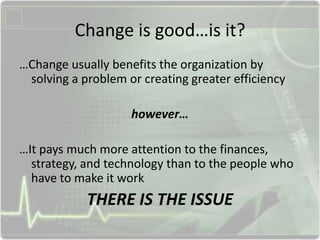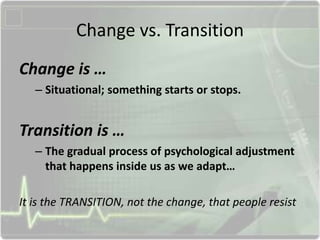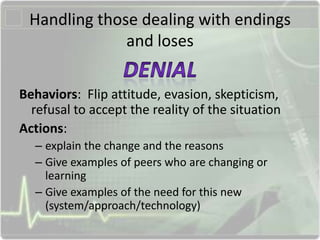Change Theory in Nursing Leadership
- 1. Change Theory in Nursing Leadership Kris Mailepors Director of Organizational Development Catholic Medical Center Ph 603-663-1961 kmailepo@cmc-nh.org Tw: @krismailepors
- 2. WHAT DOES THIS TELL YOU ABOUT CHANGE?
- 3. Three Things to Consider 1. What makes handling change so challenging? 2. What does this quote mean to you: “I’ve been in this business 36 years, I’ve learned a lot—most of it doesn’t apply anymore”
- 4. Changes just keep coming!!! From outside… • Market conditions From inside… • New technologies • New team structures • New software • New regulations • New Managers • New policies • Reduced budgets • New or unclear expectations
- 5. Change is good…is it? …Change usually benefits the organization by solving a problem or creating greater efficiency however… …It pays much more attention to the finances, strategy, and technology than to the people who have to make it work THERE IS THE ISSUE
- 6. Change vs. Transition Change is … – Situational; something starts or stops. Transition is … – The gradual process of psychological adjustment that happens inside us as we adapt… It is the TRANSITION, not the change, that people resist
- 7. The Three Phases of Transition
- 8. Why is transition resisted? • People have a personal connection to how they work; people are giving up a part of their personality • Fear of the unknown; doing and being what they have never done or been before
- 9. The Three Phases of Transition
- 10. What has ended…what is lost? • • • • • • • Turf Status Power/influence Autonomy Relationships Memberships Routine/structure • • • • • Meaningful work Control of work Personal Identity Competence Personal Future
- 11. Doing a Loss Analysis Note on the grid who is losing what
- 12. Dealing with an ending? Denial Sadness/ Anxiety Depression Bargaining Anger
- 13. Handling those dealing with endings and loses Behaviors: Flip attitude, evasion, skepticism, refusal to accept the reality of the situation Actions: – explain the change and the reasons – Give examples of peers who are changing or learning – Give examples of the need for this new (system/approach/technology)
- 14. Handling those dealing with endings and loses Behaviors: Resentment, rumor mongering, nervousness or stress, decreased productivity and effectiveness Actions: – Encourage talking and listen carefully – Don’t talk them out of feelings; offer a different point of view if you have one – Give positive feedback on their progress, if genuine – Offer accurate information to dispel rumors
- 15. Handling those dealing with endings and loses Behaviors: Grumbling, irritation, rage, mistakes, aggressiveness, foot dragging, vandalism, indignation Actions: – – – – – Listen and acknowledge anger Don’t talk them out of it Don’t assume blame for their anger Don’t collude/agree with them Recommend involving HR if extreme
- 16. Handling those dealing with endings and loses Behaviors: Attempts to get out of the situation, attempts to make deals or promises relating to the old way, negotiation Actions: – – – – – Keep realistic plan in sight Don’t be swayed by promises or negotiations Reinforce situation as it is Don’t get into problem solving or bargaining with them Gently remind them of reality
- 17. Handling those dealing with endings and loses Behaviors: Silence, “down,” or disheartened, tearfulness Actions: – Acknowledge, sympathize and reach out. – Initiate conversation and ask questions to draw them out – Encourage talking and sharing feelings either one-on-one or in small supportive groups – Promote supportive group events, interaction, or impromptu fun – Recommend to HR if appropriate
- 18. The Three Phases of Transition
- 19. Critical part: THE NEUTRAL ZONE Emotions of the Neutral Zone: – – – – Confusion Apprehension Detachment Interest/Eagerness
- 20. Communication during transition feels risky… There cannot be too much communication during the Neutral Zone. It is the difference between a bearable situation and a disaster. Two main kinds of communication in this zone:
- 21. 1. Communication designed to show CONNECTION and CONCERN. 2. Communication that clarifies the PURPOSE, the PICTURE, the PLAN, and the PART.
- 22. 1. Communication designed to show CONNECTION and CONCERN MANAGERS and leaders must keep communicating not just for more information but to show that they care. Isolation can be easily amplified during a time of transition.
- 23. 2. Communication that clarifies the PURPOSE, the PICTURE, the PLAN, and the PART. Purpose The “why’s” of the change. Purpose can serve to clear up confusion. Picture Vision of the outcome; the light at the end of the tunnel, a destination. (use an analogy—1st day)
- 24. 2. Communication that clarifies the PURPOSE, the PICTURE, the PLAN, and the PART. Plan beyond just the destination, this is the roadmap that leads there. These are step-by-step actions to get through the Neutral Zone. Part Successful transition depends on the people involved. They all play a part. Know yours, know theirs, make sure they know theirs.
- 25. The Three Phases of Transition
- 26. Creativity & Learning 1. Encourage experimentation and risk taking 2. Enhance trust 3. Expose individuals and groups to diverse perspectives 4. Provide the workforce with stimulating and interactive settings 5. Use feedback mechanisms 6. If appropriate, help people revise their career plan within the new change
- 27. The Three Phases of Transition
- 28. Getting to the … 1. Translate the changes into activity that has real meaning to the people doing it 2. Provide people with the opportunity to practice or gain familiarity 3. Work collaboratively 4. Focus on efforts and achieve a few “quick successes” 5. Build RESPONSIVENESS and FLEXIBILITY into your routine
- 29. 7 things to remember! 1. You have to end before you begin 2. Between the end and the new beginning, there is a hiatus 3. That hiatus can be creative 4. People go through transition at different speeds, and may be affected by different things 5. *Most* organizations are running a deficit in transition management
- 30. People May Hate Change… …But they love Progress Reference: www.wmbridges.com; www.linkageinc.com






























